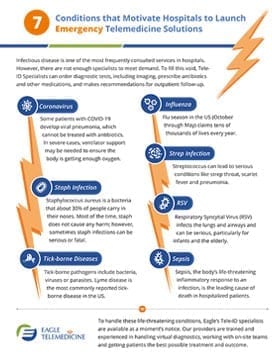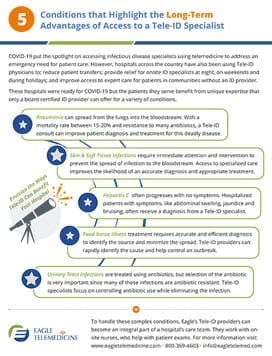As the pandemic ramped up, and hospitals faced a surge in patients with telemedicine conditions providers can diagnose and treat remotely. At the same time, the lack of onsite infectious disease (ID) specialists became critical. The confluence of a specialist shortage and a telemedicine solution led many hospitals to seek out emergency hospital telemedicine programs.
Rural and small community hospitals were especially affected by the shortage of ID physicians, as most don’t have the resources or patient need to keep this type of specialist on staff full-time. Instead, they rely on internal medicine or emergency medicine practitioners who don’t have the ID expertise.
Infectious disease is one of the most frequently consulted service in most hospitals. However, several media outlets are projecting a shortage of infectious disease providers. Furthermore, a maldistribution of these specialists exacerbates this shortage by limiting the locations where infectious disease telehealth physicians are available for consult.
ID physicians are primarily operating out of major metropolitan areas on the east and west coast of the United States. Large swaths of the south and mid-west have less than one infectious disease doctor per 100,000 people. And yet, there is an abundance of these specialists in some regions.
To fill the void, Eagle was inundated with requests for Tele-ID specialists who could quickly “beam in” to guide patient diagnosis and treatment during the spread of COVID-19.
Tele-ID Keeps Hospitals Performing During Crisis
“If we suspect the coronavirus, we are prepared with special isolation units and routine contact isolation kits for clinical staff—a gown and gloves. Also, a mask with a clear shield that covers the eyes to protect from exposure to moisture droplets should the patient cough or sneeze.”

Dr. David Fitzgerald, an Eagle Tele-ID specialist, has been in the thick of the COVID-19 crisis. He says that on-the-ground Emergency Department and internal medicine doctors were instrumental in making the initial COVID-19 diagnoses. Then, a Tele-ID specialist could join in a consult with patients and the local healthcare team.
“Very often, it’s a nurse who works with us, who helps with the exam,” says Fitzgerald, “then we develop the treatment plan, share it with the local team, and bring in subspecialists when needed, like a pulmonologist, cardiologist or renal Specialist.”
But COVID-19 is just one condition that prompts hospitals to launch a crisis-oriented Tele-ID solution. Infectious disease specialists diagnose and treat a broad range of conditions ― pneumonia, respiratory failure, sepsis and other life-threatening conditions.
A Tele-ID specialist can order diagnostic tests, including imaging, prescribe antibiotics and other medications, and makes recommendations for outpatient follow-up.
Telemedicine Conditions that Trigger Tele-ID Programs
1. Coronaviruses/COVID-19
COVID-19 is just one of hundreds of coronaviruses, a large family of viruses that usually cause mild to moderate upper-respiratory tract illnesses, like the common cold. Some patients with COVID-19 develop viral pneumonia, which cannot be treated with antibiotics. In severe cases, ventilator support may be needed to ensure the body is getting enough oxygen. Studies show that in patients with COVID-19, pneumonia may progress into acute respiratory distress syndrome (ARDS), which can be fatal in some patients.
2. Influenza
Flu infection can present particularly serious problems for young children, the elderly, pregnant women and people with certain medical conditions, such as asthma and heart disease. When a new flu virus strain emerges for which humans have little to no immunity, the virus can spread easily from person-to-person.
Flu season in the US, which runs from October through May, claims tens of thousands of lives every year. Fears of a COVID-19 “twindemic” have been very real. Public health officials are hopeful that the COVID-19 precautions will decrease this risk. However, given the number of hospital bed shortages across the country, and the typical beds required for flu-related hospitalizations, there is fear the healthcare system could be overburdened. Influenza is one of many conditions telemedicine physicans can diagnose and treat in an inpatient setting.
3. Staph Infections/MRSA
Staphylococcus aureus is a germ that about 30% of people carry in their noses. Most of the time, staph does not cause any harm; however, sometimes staph causes infections.
In healthcare settings, these staph infections can be serious or fatal, including:
- Bacteremia or sepsis when bacteria spread to the bloodstream.
- Pneumonia, which most often affects people with underlying lung disease including those on mechanical ventilators.
- Endocarditis (infection of the heart valves), which can lead to heart failure or stroke.
- Osteomyelitis (bone infection), which can be caused by staph bacteria traveling in the bloodstream or put there by direct contact such as following trauma (puncture wound of foot or intravenous (IV) drug abuse).
MRSA or Methicillin-resistant Staphylococcus aureus is a dangerous staph infection that can be resistant to antibiotics. Though most MRSA infections aren’t serious, some can be life-threatening. Many public health experts are alarmed by the spread of tough strains of MRSA as they are resistant to many common antibiotics. While some antibiotics still work, MRSA is constantly adapting. Researchers developing new antibiotics are having a tough time keeping up.
4. Strep Infections
Streptococcus Groups A and B cause most strep infections. Group A strep causes strep throat, scarlet fever, impetigo, Toxic shock syndrome. cellulitis and necrotizing fasciitis (flesh-eating disease).
Group B strep can cause blood infections, pneumonia and meningitis in newborns. Strep B can also cause urinary tract infections, blood infections, skin infections and pneumonia in adults. Antibiotics are used to treat strep infections.
5. Respiratory syncytial virus (RSV)
RSV infects the lungs and breathing passages, and can be serious, particularly for infants and the elderly. RSV is the most common cause of bronchiolitis (inflammation of the small airways in the lung) and pneumonia in children younger than 1 year of age.
6. Tickborne Diseases
Tick-borne pathogens include bacteria, viruses, or parasites. The most common tick-borne diseases in the US include: Lyme disease, babesiosis, ehrlichiosis, Rocky Mountain Spotted Fever, anaplasmosis, Southern Tick-Associated Rash Illness, Tick-Borne Relapsing Fever, and tularemia. Other tick-borne diseases in the United States include: Colorado tick fever, Powassan encephalitis, and Q fever.
Lyme disease is the most commonly reported tick-borne disease in the US. The number of counties in the northeastern and upper Midwestern US considered high-risk for Lyme disease increased by over 300% in the past two decades.
7. Sepsis Infections
Sepsis is also one of the telemedicine conditions that trigger a need for emergency telemedicine solutions. Sepsis, the body’s life-threatening inflammatory response to an infection, is the leading cause of death in hospitalized patients. Mortality rate is estimated between 25 and 50 percent. Sepsis is also the most expensive disease to treat in the hospital, costing approximately $17 billion dollars each year.
Despite improvements in sepsis outcomes over the past decades, the incidence of sepsis has dramatically increased. The aging population with more predisposing comorbidities, more frequent use of immunosuppression, and more invasive procedures and medical devices are believed to contribute to this increase. Also, the spread of multi-drug resistant pathogens is a contributor.
Improved sepsis recognition, faster treatment, and general improvements in the care of critically ill patients has led to the decline of sepsis-associated mortality rates.
Treat Telemedicine Conditions in Minutes with Tele-ID
To handle these life-threatening conditions, Eagle’s Tele-ID specialists can be available at a moment’s notice — whether it’s an ER emergency or a hospitalized patient. These Specialists are trained and experienced in handling virtual diagnostics, working with on-site teams, and getting patients the best possible treatment and outcome.
The Tele-ID can handle a Code Blue situation, calling orders from the bedside — just as if they were on-site. They work closely with on-site teams to ensure everyone knows their role. The entire procedure is seamless, and patients are engaged as much as possible. Patients have embraced telemedicine, grateful to have a seasoned specialist guiding their treatment. And Specialists are experts not just in their medical specialty, but also in their bedside manner.








